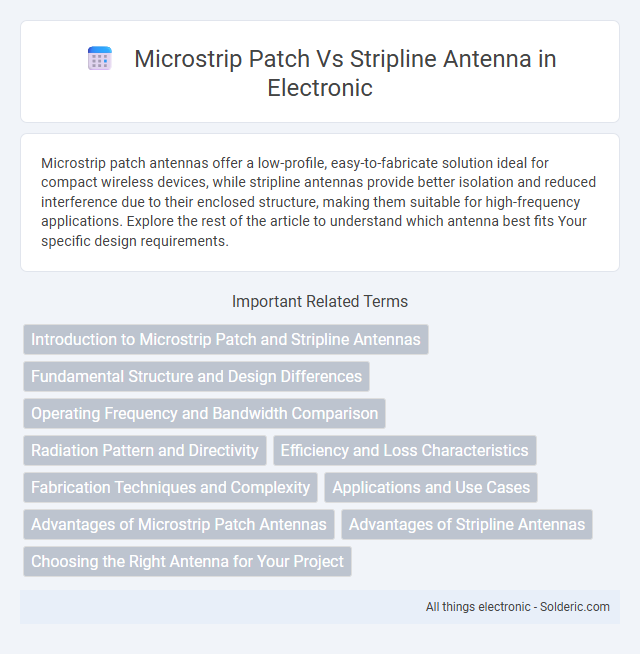Microstrip patch antennas offer a low-profile, easy-to-fabricate solution ideal for compact wireless devices, while stripline antennas provide better isolation and reduced interference due to their enclosed structure, making them suitable for high-frequency applications. Explore the rest of the article to understand which antenna best fits Your specific design requirements.
Comparison Table
| Feature | Microstrip Patch Antenna | Stripline Antenna |
|---|---|---|
| Structure | Flat rectangular patch on dielectric substrate, with ground plane underneath | Conductor embedded between two ground planes inside dielectric substrate |
| Radiation Pattern | Broadside with moderate directivity | Directional, better isolation and confinement |
| Bandwidth | Narrow bandwidth (a few %) | Wider bandwidth relative to microstrip |
| Size | Compact and low profile | Compact but thicker due to substrate layering |
| Manufacturing Complexity | Simple, low cost PCB fabrication | More complex multilayer fabrication |
| Losses | Moderate dielectric and conductor losses | Lower losses due to shielded structure |
| Application | Wireless devices, GPS, satellites | High-frequency circuits, radar, microwave systems |
Introduction to Microstrip Patch and Stripline Antennas
Microstrip patch antennas consist of a flat rectangular or circular metal patch mounted on a grounded substrate, known for their low profile, lightweight, and ease of fabrication. Stripline antennas feature a conductor sandwiched between two dielectric layers and ground planes, providing excellent shielding and minimal radiation loss. Your choice between these antennas will depend on size, bandwidth, and integration requirements for wireless communication systems.
Fundamental Structure and Design Differences
Microstrip patch antennas consist of a radiating patch on one side of a dielectric substrate with a ground plane on the opposite side, enabling easy fabrication and integration with printed circuit boards. Stripline antennas feature a conductor sandwiched between two parallel ground planes within a dielectric medium, providing enhanced shielding and reduced electromagnetic interference. The microstrip patch design supports surface-wave propagation leading to higher radiation losses, whereas the stripline's enclosed structure offers better field confinement and stability in high-frequency applications.
Operating Frequency and Bandwidth Comparison
Microstrip patch antennas generally operate efficiently in the microwave frequency range from 1 GHz to 40 GHz, offering moderate bandwidth typically between 1% and 5%, whereas stripline antennas provide broader bandwidth capabilities that can extend up to 10% or more due to their multilayer structure. The thin substrate and open structure of microstrip patches limit their bandwidth and frequency range, while striplines benefit from a shielded transmission line environment, resulting in improved impedance matching and reduced radiation losses. Design parameters such as substrate thickness, dielectric constant, and feeding techniques critically influence the operating frequency and bandwidth for both antenna types.
Radiation Pattern and Directivity
Microstrip patch antennas typically exhibit a broadside radiation pattern with moderate directivity suitable for short-range and indoor applications. Stripline antennas offer a more confined, end-fire radiation pattern with higher directivity, making them ideal for point-to-point communication. The choice between microstrip patch and stripline antennas depends on the specific directivity requirements and spatial constraints of the wireless system.
Efficiency and Loss Characteristics
Microstrip patch antennas typically exhibit lower efficiency due to higher surface wave and dielectric losses compared to stripline antennas, which benefit from enclosed structures that reduce radiation losses. Stripline antennas offer improved loss characteristics by confining electromagnetic energy within dielectric substrates, minimizing signal leakage and enhancing overall power transfer efficiency. Your choice depends on whether compact design or superior efficiency with minimized losses is the priority for your application.
Fabrication Techniques and Complexity
Microstrip patch antennas feature simple fabrication using printed circuit board (PCB) technology, making them cost-effective and suitable for mass production. Stripline antennas require more intricate manufacturing processes involving multilayer substrates and precise via placements, increasing complexity and fabrication costs. Your choice depends on the balance between fabrication ease and the specific RF performance needs of your application.
Applications and Use Cases
Microstrip patch antennas are widely used in mobile devices, satellite communication, and GPS systems due to their low profile and ease of integration on flat surfaces. Stripline antennas excel in aerospace and military applications where enclosed, shielded environments are crucial for minimizing interference and enhancing signal integrity. Your choice depends on the need for compactness and surface mounting (microstrip) versus high isolation and environmental protection (stripline).
Advantages of Microstrip Patch Antennas
Microstrip patch antennas offer advantages such as lightweight construction, low profile, and ease of fabrication on printed circuit boards, making them ideal for compact wireless devices. Their planar structure enables seamless integration with microwave circuits and supports versatile shapes for tailored radiation patterns. You benefit from low-cost mass production and wide application in mobile, satellite, and RFID systems.
Advantages of Stripline Antennas
Stripline antennas offer superior shielding and reduced electromagnetic interference due to their embedded structure within dielectric layers, enhancing signal integrity in dense electronic environments. Their compact form factor enables integration into multilayer circuit boards, making them ideal for miniaturized wireless devices and complex microwave systems. The stripline configuration also provides consistent impedance control, which improves beam stability and frequency performance compared to microstrip patch antennas.
Choosing the Right Antenna for Your Project
Microstrip patch antennas offer compact size, low profile, and ease of fabrication, making them ideal for applications requiring planar integration and moderate bandwidth, such as wireless communication and GPS devices. Stripline antennas provide better shielding and reduced electromagnetic interference due to their enclosed structure, suitable for high-frequency circuits demanding signal integrity and controlled impedance. Selecting between microstrip patch and stripline antennas depends on application requirements like bandwidth, size constraints, and environmental noise tolerance to achieve optimal performance.
microstrip patch vs stripline antenna Infographic

 solderic.com
solderic.com